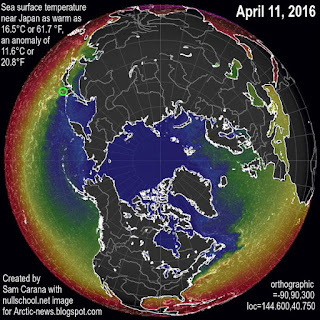The coordinates of the wildfire are in the bottom left corner of above map. They show a location where, on May 3, 2016, it was 26.0°C (or 78.8°F). At a nearby location, it was 27.6°C (or 81.8°F) on May 3, 2016. Both locations are indicated on the map on the right.
These locations are on the path followed by the Mackenzie River, which ends up in the Arctic Ocean. Wildfires aggravate heat waves as they blacken the soil with soot. As the Mackenzie River heats up, it will bring warmer water into the Arctic Ocean where this will speed up melting of the sea ice.
Moreover, winds can carry soot high up into the Arctic, where it can settle on the sea ice and darken the surface, which will make that more sunlight gets absorbed, rather than reflected back into space as before.
The danger of wildfires increases as temperatures rise. The image on the right show that temperatures in this area on May 3, 2016 (00:00 UTC) were at the top end of the scale, i.e. 20°C or 36°F warmer than 1979-2000 temperatures.
 Extreme weather is becoming increasingly common, as changes are taking place to the jet stream. As the Arctic warms up more rapidly than the rest of the world, the temperature difference between the Equator and the North Pole decreases, which in turn weakens the speed at which the north polar jet stream circumnavigates the globe.
Extreme weather is becoming increasingly common, as changes are taking place to the jet stream. As the Arctic warms up more rapidly than the rest of the world, the temperature difference between the Equator and the North Pole decreases, which in turn weakens the speed at which the north polar jet stream circumnavigates the globe. This is illustrated by the wavy patterns of the jet stream in the image on the right, showing the situation on May 3, 2016 (00:00 UTC), with a loop bringing warm air high up into North America and into the Arctic.
In conclusion, warm air reaching high latitudes is causing the sea ice to melt in a number of ways:
- Warm air makes the ice melt directly.
- Warmer water in rivers warms up the Arctic Ocean.
- Wildfires blacken land and sea ice, causing more sunlight to be absorbed, rather than reflected back into space as before.
 |
| [ click on images to enlarge ] |
Further decline of the snow and ice cover in the Arctic looks set to make a number of feedbacks kick in stronger, with methane releases from the seafloor of the Arctic Ocean looming as a huge danger.
NSIDC scientist Andrew Slater has created the chart below of freezing degree days in 2016 compared to other years at Latitude 80°N. See Andrew's website and this page for more on this.
Below is a comparison of temperatures and emissions for the two locations discussed above. Such fires are becoming increasingly common as temperatures rise, and they can cause release of huge amounts of carbon dioxide, carbon monoxide, methane, sulfur dioxide, soot, etc.
 |
| May 3, 2016, at a location north of Fort St John, British Columbia, Canada. |
 |
| May 4, 2016, near Fort McMurray, Alberta, Canada. |
In the video below, Paul Beckwith discusses the situation.
Wildfires are also devastating other parts of the Earth. Below is an image showing wildfires over the Amur River on May 7, 2016.
The image below shows carbon monoxide levels over the Amur River as high as 22,480 ppb on May 9, 2016. Hat tip to Grofu Antoniu for pointing at the CO levels. According to this Sputniknews report, a state of emergency was declared in the Amur Region as fires stretched across 12,200 acres.
The video below shows carbon monoxide emissions in eastern Asia from May 1 to May 26, 2016.
Meanwhile, the National Snow and Ice Data Center (NSIDC) has resumed daily sea ice extent updates with provisional data. The image below is dated May 5, 2016, check here for updates.
As illustrated by the image below, from JAXA, sea ice extent on May 6, 2016, was under 12 million square km, more than 15 days ahead on extent in the year 2012, which was 12 million square km on May 21, 2012.
The situation is dire and calls for comprehensive and effective action as described in the Climate Plan.
Malcolm Light comments:
|
Links
• The Threat of Wildfires in the North
http://arctic-news.blogspot.com/2013/06/the-threat-of-wildfires-in-the-north.html
• Smoke Blankets North America
http://arctic-news.blogspot.com/2014/07/smoke-blankets-north-america.html
• Wildfires even more damaging
http://arctic-news.blogspot.com/2013/07/wildfires-even-more-damaging.html
• Wildfires in Canada affect the Arctic
http://arctic-news.blogspot.com/2013/07/wildfires-in-canada-affect-the-arctic.html
• Wildfires even more damaging
http://arctic-news.blogspot.com/2013/07/wildfires-even-more-damaging.html
• Wildfires in Canada affect the Arctic
http://arctic-news.blogspot.com/2013/07/wildfires-in-canada-affect-the-arctic.html
















































